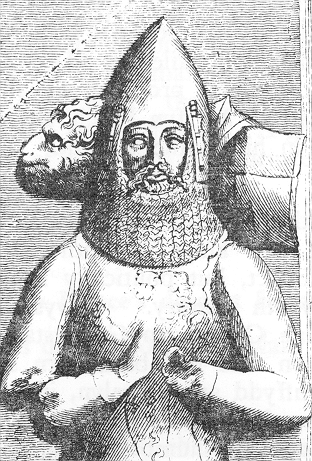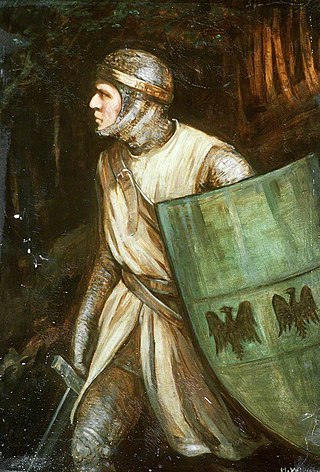Related Research Articles

Rhys ap Gruffydd or ap Gruffudd was the ruler of the kingdom of Deheubarth in south Wales from 1155 to 1197. Today, he is commonly known as The Lord Rhys, in Welsh Yr Arglwydd Rhys, although this title may have not been used in his lifetime. He usually used the title "Proprietary Prince of Deheubarth" or "Prince of South Wales", but two documents have been discovered in which he uses the title "Prince of Wales" or "Prince of the Welsh". Rhys was one of the most successful and powerful Welsh princes, and, after the death of Owain Gwynedd of Gwynedd in 1170, the dominant power in Wales.

Llywelyn ap Gruffudd, Llywelyn II, also known as Llywelyn the Last, was the prince of Gwynedd, and later was recognised as the prince of Wales from 1258 until his death at Cilmeri in 1282. Llywelyn was the son of Gruffydd ap Llywelyn Fawr and grandson of Llywelyn the Great, and he was one of the last native and independent princes of Wales before its conquest by Edward I of England and English rule in Wales that followed, until Owain Glyndŵr held the title during the Welsh Revolt of 1400–1415.
Llywelyn ab Iorwerth, also known as Llywelyn the Great, was a medieval Welsh ruler. He succeeded his uncle, Dafydd ab Owain Gwynedd, as King of Gwynedd in 1195. By a combination of war and diplomacy he dominated Wales for 45 years.

Owain ap Gruffudd was King of Gwynedd, North Wales, from 1137 until his death in 1170, succeeding his father Gruffudd ap Cynan. He was called Owain the Great and the first to be styled "Prince of Wales", and the "Prince of the Welsh". He is considered to be the most successful of all the North Welsh princes prior to his grandson, Llywelyn the Great. He became known as Owain Gwynedd to distinguish him from the contemporary king of Powys Wenwynwyn, Owain ap Gruffydd ap Maredudd, who became known as Owain Cyfeiliog.

Deheubarth was a regional name for the realms of south Wales, particularly as opposed to Gwynedd. It is now used as a shorthand for the various realms united under the House of Dinefwr, but that Deheubarth itself was not considered a proper kingdom on the model of Gwynedd, Powys, or Dyfed is shown by its rendering in Latin as dextralis pars or as Britonnes dexterales and not as a named land. In the oldest British writers, Deheubarth was used for all of modern Wales to distinguish it from Hen Ogledd, the northern lands whence Cunedda originated.

The Kingdom of Gwynedd was a Welsh kingdom and a Roman Empire successor state that emerged in sub-Roman Britain in the 5th century during the Anglo-Saxon settlement of Britain.

The Kingdom of Powys was a Welsh successor state, petty kingdom and principality that emerged during the Middle Ages following the end of Roman rule in Britain. It very roughly covered the northern two-thirds of the modern county of Powys and part of today's English West Midlands. More precisely, and based on the Romano-British tribal lands of the Ordovices in the west and the Cornovii in the east, its boundaries originally extended from the Cambrian Mountains in the west to include the modern West Midlands region of England in the east. The fertile river valleys of the Severn and Tern are found here, and this region is referred to in later Welsh literature as "the Paradise of Powys".
Dafydd ab Owain Gwynedd was Prince of Gwynedd from 1170 to 1195. For a time he ruled jointly with his brothers Maelgwn ab Owain Gwynedd and Rhodri ab Owain Gwynedd.
Owain ap Gruffudd was brother to Llywelyn ap Gruffudd and Dafydd ap Gruffudd and, for a brief period in the late 1240s and early 1250s, ruler of part of the Kingdom of Gwynedd.
Hywel ab Owain Gwynedd, Prince of Gwynedd in 1170, was a Welsh poet and military leader. Hywel was the son of Owain Gwynedd, prince of Gwynedd, and an Irishwoman named Pyfog. In recognition of this, he was also known as Hywel ap Gwyddeles. Hywel is also known as the Poet Prince for his bardic skills.
Rhodri ab Owain Gwynedd was prince of part of Gwynedd, one of the kingdoms of medieval Wales. He ruled from 1175 to 1195.
Owain Danwyn was a king of Rhos in Gwynedd, northwestern Wales, in the mid-5th century. He was the son of Einion Yrth and the father of Cynlas Goch, probably the Cuneglasus excoriated by Gildas. Very little is known of his life. Graham Phillips and Martin Keatman proposed a theory that he was the historical figure behind the legend of King Arthur.
Perfeddwlad or Y Berfeddwlad was an historic name for the territories in Wales lying between the River Conwy and the River Dee. comprising the cantrefi of Rhos, Rhufoniog, Dyffryn Clwyd and Tegeingl. Perfeddwlad thus was also known as the Four Cantrefs.
Gruffudd ap Cynan ab Owain Gwynedd was the grandson of Owain Gwynedd, a famous king of Gwynedd and ruler of most of Wales in the 12th century. The longer patronymic form of his name is usually used to distinguish him from the earlier and better-known Gruffudd ap Cynan, king of Gwynedd.
This article is about the particular significance of the century 1101–1200 to Wales and its people.

The history of Gwynedd in the High Middle Ages is a period in the History of Wales spanning the 11th through the 13th centuries. Gwynedd, located in the north of Wales, eventually became the most dominant of Welsh polities during this period. Contact with continental courts allowed for Gwynedd to transition from a petty kingdom into an increasingly sophisticated principality of seasoned courtiers capable of high level deplomacy and representation; not only with the Angevine kings, but also the king of France and the Papal See. Distinctive achievements in Gwynedd include further development of Medieval Welsh literature, particularly poets known as the Beirdd y Tywysogion associated with the court of Gwynedd; the reformation of bardic schools; and the continued development of Cyfraith Hywel. All three of these further contributed to the development of a Welsh national identity in the face of Anglo-Norman encroachment of Wales.

Anwyl of Tywyn are a Welsh family who claim a patrilinear descent from Owain Gwynedd, King of Gwynedd from 1137 to 1170 and a scion of the royal House of Aberffraw. The family motto is: Eryr eryrod Eryri, which translates as "The Eagle of the Eagles of Snowdonia. The family lives in Gwynedd and speak Welsh.
Emmaof Anjou (c.1140–c.1214) was an illegitimate daughter of Geoffrey Plantagenet, Count of Anjou, and half-sister of King Henry II of England. She was married to Dafydd ab Owain Gwynedd, a Welsh prince. She is occasionally confused with Emma de Laval (1200-1264), the daughter of Guy V de Laval. Emma married Dafydd in the summer of 1174, after an unsuccessful rebellion by the queen, Eleanor of Aquitaine, and her older sons had led her half-brother the king to disperse Eleanor's court in Aquitaine and bring Emma back to England.
References
- ↑ "Maelgwn ab Owain Gwynedd". Dictionary of Welsh Biography. Retrieved 14 April 2016.